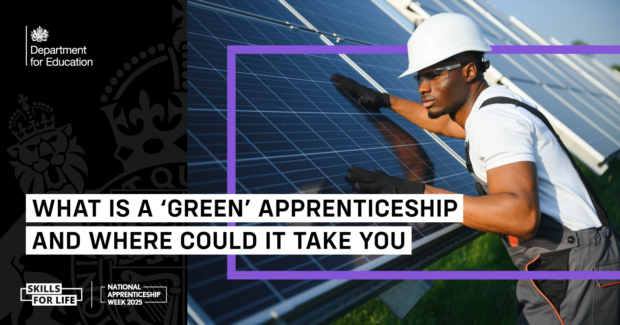
This series of National Apprenticeship Week Education Hub posts was curated and written by Lauren, the Department for Education’s new communications apprentice.

There are a range of apprenticeships available in the green economy and during National Apprentice Week we want to shed light on the range of green apprenticeships that are out there.
What are green apprenticeships?
A green apprenticeship gives the learner the skills they need to do a job in a green sector. Green jobs are roles in activities that contribute to protecting and restoring the environment and maybe even climate change.
Whether you want to get on in a sustainable career or join the growing band of engineers working on clean energy, there are a range of paid green apprenticeships across the country leading to exciting careers that can also help the fight against climate change.
From nature restoration to nuclear power, there are a huge range of opportunities out there for anyone looking to train and join the green workforce. Here are just a few examples:
Low carbon Heating Technician (Level 3) - Heat Pump Engineer
Heat pump engineers install and service zero carbon central heating and hot water systems in buildings.
Heat pump engineers earn from £24,000 fresh out of training and have the opportunity to use the latest equipment. Heat pump engineers are in high demand, with the heat pump association estimating that 70,000 heat pump technicians are needed by 2035.
Working as a low carbon heat technician apprentice means learning both in college and on the job, shadowing and doing practical work to develop the skills and knowledge needed to have a career in the industry following your apprenticeship.
Entry requirements for this apprenticeship are usually 4-5 GCESs at grade 9-4 (A* - C) or equivalent, which may include English and maths, but this varies with each employer.
Following your apprenticeship there are opportunities to become a heat pump installer or even a solar heating installer. You may work for yourself or a company.
You could also go further with your study to develop your skill set even more.
Wind Turbine Technician Apprenticeship (Level 3)
A wind turbine technician apprenticeship is ideal for those who are interested in maintaining large wind turbines. Wind turbine technicians provide the hands-on maintenance that turbines need to operate.
Like all apprenticeships, the wind turbine technician apprenticeship combines on the job practical work and classroom learning. You will learn core knowledge and skills about the operational practices of wind turbines, such as how to test equipment performance.
The wind turbine technician apprenticeship typically takes 36-42 months to complete. You will achieve a level 3 qualification while doing this apprenticeship.
Generally, your job title after completing this apprenticeship would be an engineering technician. You could work with different companies that are involved in multi-national corporations, or you could work for smaller local businesses.
Civil Engineer (Level 6)
Civil engineers are vital to a range of major projects, providing design solutions for complex engineering problems. As a civil engineer, you will work with a team of engineers and other professionals in the construction industry throughout the stages of development for various projects.
By completing a civil engineering apprenticeship, you will be able to gain skills in a range of different areas from sustainable construction to engineering behaviour of earth materials.
As a civil engineer you could work in the public sector for the government, local authorities, or organisations like the NHS. You could also work in the private sector at an engineering consultancy practice or a research and development organisation.
There are a range of routes you can take to get to a level 6 civil engineering apprenticeship. You may want to first complete a level 3 or 4 qualification in civil engineering, such as the level 3 civil engineering technician or level 4 civil engineering senior technician apprenticeship. You can also apply after finishing school or college. You will usually need 4 or 5 GCSEs at grades 9-4 (A*-C) and A levels (or equivalent).
After completing this apprenticeship, you will be a fully qualified, chartered civil engineer with an average salary of £44,341. There are a broad range of specialisms you can go onto work in, such as transport, infrastructure, and public buildings.
What skills do I need to start a green apprenticeship?
Apprenticeships in the green economy require people to be good team workers and strong collaborators.
Problem solving and communicating are also crucial skills to working in the green sector.
It may be useful to have some understanding of climate change and sustainability, but it isn’t essential, as apprentices learn as they go and will develop these skills and more as they work and train.
To find out more about other apprenticeships available Click here